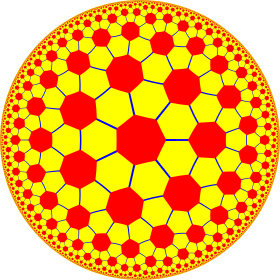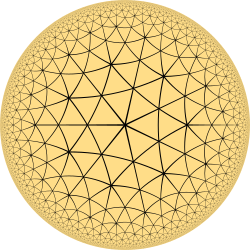

| Truncated order-7 triangular tiling | |
|---|---|
 Poincaré disk model of the hyperbolic plane | |
| Type | Hyperbolic uniform tiling |
| Vertex configuration | 7.6.6 |
| Schläfli symbol | t{3,7} |
| Wythoff symbol | 2 7 |3 |
| Coxeter diagram | |
| Symmetry group | [7,3], (*732) |
| Dual | Heptakis heptagonal tiling |
| Properties | Vertex-transitive |
Ingeometry, the order-7 truncated triangular tiling, sometimes called the hyperbolic soccerball,[1] is a semiregular tiling of the hyperbolic plane. There are two hexagons and one heptagon on each vertex, forming a pattern similar to a conventional soccer ball (truncated icosahedron) with heptagons in place of pentagons. It has Schläfli symbol of t{3,7}.
This tiling is called a hyperbolic soccerball (football) for its similarity to the truncated icosahedron pattern used on soccer balls. Small portions of it as a hyperbolic surface can be constructed in 3-space.
 Atruncated icosahedron as a polyhedron and a ball |
 The Euclidean hexagonal tiling colored as truncated triangular tiling |
 A paper construction of a hyperbolic soccerball |
The dual tiling is called a heptakis heptagonal tiling, named for being constructible as a heptagonal tiling with every heptagon divided into seven triangles by the center point.

This hyperbolic tiling is topologically related as a part of sequence of uniform truncated polyhedra with vertex configurations (n.6.6), and [n,3] Coxeter group symmetry.
| *n32 symmetry mutation of truncated tilings: n.6.6
| ||||||||||||
|---|---|---|---|---|---|---|---|---|---|---|---|---|
| Sym. *n42 [n,3] |
Spherical | Euclid. | Compact | Parac. | Noncompact hyperbolic | |||||||
| *232 [2,3] |
*332 [3,3] |
*432 [4,3] |
*532 [5,3] |
*632 [6,3] |
*732 [7,3] |
*832 [8,3]... |
*∞32 [∞,3] |
[12i,3] | [9i,3] | [6i,3] | ||
| Truncated figures |

|

|

|

|

|

|

|

|

|

|

| |
| Config. | 2.6.6 | 3.6.6 | 4.6.6 | 5.6.6 | 6.6.6 | 7.6.6 | 8.6.6 | ∞.6.6 | 12i.6.6 | 9i.6.6 | 6i.6.6 | |
| n-kis figures |

|

|

|

|

|

|

|

|
||||
| Config. | V2.6.6 | V3.6.6 | V4.6.6 | V5.6.6 | V6.6.6 | V7.6.6 | V8.6.6 | V∞.6.6 | V12i.6.6 | V9i.6.6 | V6i.6.6 | |
From a Wythoff construction there are eight hyperbolic uniform tilings that can be based from the regular heptagonal tiling.
Drawing the tiles colored as red on the original faces, yellow at the original vertices, and blue along the original edges, there are 8 forms.
| Uniform heptagonal/triangular tilings
| |||||||||||
|---|---|---|---|---|---|---|---|---|---|---|---|
| Symmetry: [7,3], (*732) | [7,3]+, (732) | ||||||||||

|

|

|

|

|

|

|

| ||||
| {7,3} | t{7,3} | r{7,3} | t{3,7} | {3,7} | rr{7,3} | tr{7,3} | sr{7,3} | ||||
| Uniform duals | |||||||||||

|

|

|

|

|

|

|

| ||||
| V73 | V3.14.14 | V3.7.3.7 | V6.6.7 | V37 | V3.4.7.4 | V4.6.14 | V3.3.3.3.7 | ||||
This tiling features prominently in HyperRogue.
|
| ||||||
|---|---|---|---|---|---|---|
| ||||||
| ||||||
| ||||||
| ||||||